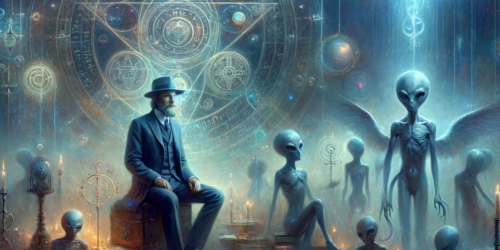Zecharia Sitchin

Zecharia Sitchin was a fascinating figure in the annals of alternative history and fringe science, known for his unique interpretations of ancient texts and his hypothesis about extraterrestrial influences on early human civilization. Born in Baku, Azerbaijan SSR, in 1920 and raised in Mandatory Palestine, Sitchin was an autodidact in various disciplines, although his formal education was in economics. He graduated from the London School of Economics and Political Science, an institution affiliated with the University of London. His professional background was primarily in journalism and writing, with a stint as an editor and journalist in Israel before moving to New York in 1952.
Sitchin’s connection to Unidentified Aerial Phenomena (UAP) and Unidentified Flying Objects (UFO) lies in his theories regarding the Anunnaki, a group of deities in ancient Mesopotamian cultures. His hypothesis, detailed in his series of books called “The Earth Chronicles,” posits that these deities were, in fact, extraterrestrial beings who visited Earth from a planet in our solar system called Nibiru.
Now, it’s crucial to understand that Sitchin’s ideas do not reflect the scientific consensus. For instance, the existence of Nibiru, as described by Sitchin, is not supported by contemporary astronomy. However, Sitchin’s work has had a broad influence on a variety of UAP and UFO theories, contributing to a narrative that suggests advanced civilizations may have visited Earth in the distant past.
- His detailed analysis of Sumerian and Akkadian cylinder seals, from which he extrapolates his theories. This fact is documented in his book “The 12th Planet” and in various interviews he conducted over the years.
- His assertion that nuclear war took place on Earth around 4,000 B.C., as discussed in his book “The Wars of Gods and Men.”
- His belief that the construction of the pyramids was influenced by extraterrestrial technology, as discussed in his book “The Stairway to Heaven.”
Michael S. Heiser, an expert in ancient Semitic languages, has critiqued Sitchin’s understanding of Sumerian and other ancient languages, suggesting that Sitchin’s interpretations do not align with the mainstream understanding of these texts (source: Michael Heiser’s official website).
The books written by Sitchin include “The 12th Planet,” “The Stairway to Heaven,” “The Wars of Gods and Men,” “The Lost Realms,” “When Time Began,” “The Cosmic Code,” “The End of Days,” and others. Each one explores different aspects of his theories, ranging from the origins of humanity to the prophesied future of our species. Sitchin was indeed the author of these books, dedicating much of his life to researching, interpreting, and writing about ancient civilizations and their potential connections to extraterrestrial entities.
While there are no mainstream biographies dedicated solely to the life of Zecharia Sitchin, his influence is discussed in many books about ancient astronaut theories and alternative interpretations of human history. For instance, “Chariots of the Gods?” by Erich Von Däniken, explores similar themes and acknowledges Sitchin’s contributions to these ideas.
A 2010 article in The New York Times mentioned Sitchin in the context of people who believe in the existence of Nibiru or Planet X.
There are eight officially recognized planets in our solar system. They are, in order of their distance from the Sun:
- Mercury
- Venus
- Earth
- Mars
- Jupiter
- Saturn
- Uranus
- Neptune
In 2006, the International Astronomical Union (IAU) redefined the criteria for classifying celestial objects as planets, which led to the demotion of Pluto from planet status to a “dwarf planet.” Since then, Pluto and other similarly-sized celestial bodies in our solar system are no longer considered planets.
There are five recognized dwarf planets in our solar system according to the International Astronomical Union (IAU). These are:
- Pluto: Once considered the ninth planet in our solar system, it was reclassified as a dwarf planet in 2006.
- Eris: Discovered in 2005, Eris is slightly larger than Pluto and is located in the scattered disc, a region beyond the Kuiper Belt.
- Haumea: Discovered in 2004, Haumea is unique for its elongated shape, believed to be caused by its rapid rotation.
- Makemake: Discovered in 2005, Makemake is the second-brightest object in the Kuiper Belt as viewed from Earth (after Pluto).
- Ceres: Located in the asteroid belt between Mars and Jupiter, Ceres is the smallest recognized dwarf planet and the only one located in the inner solar system.
It’s worth noting that there are many other objects in our solar system that could potentially be classified as dwarf planets, pending further observation and study.
Zecharia Sitchin was a figure of enduring fascination in the world of alternative history and ancient astronaut theories. Despite the controversy and skepticism surrounding his work, his ideas about ancient civilizations and extraterrestrial influences continue to captivate a segment of the population. His extensive body of work, including his series “The Earth Chronicles,” has left an indelible mark on the way we interpret ancient texts and artifacts and consider the possibility of extraterrestrial life.



